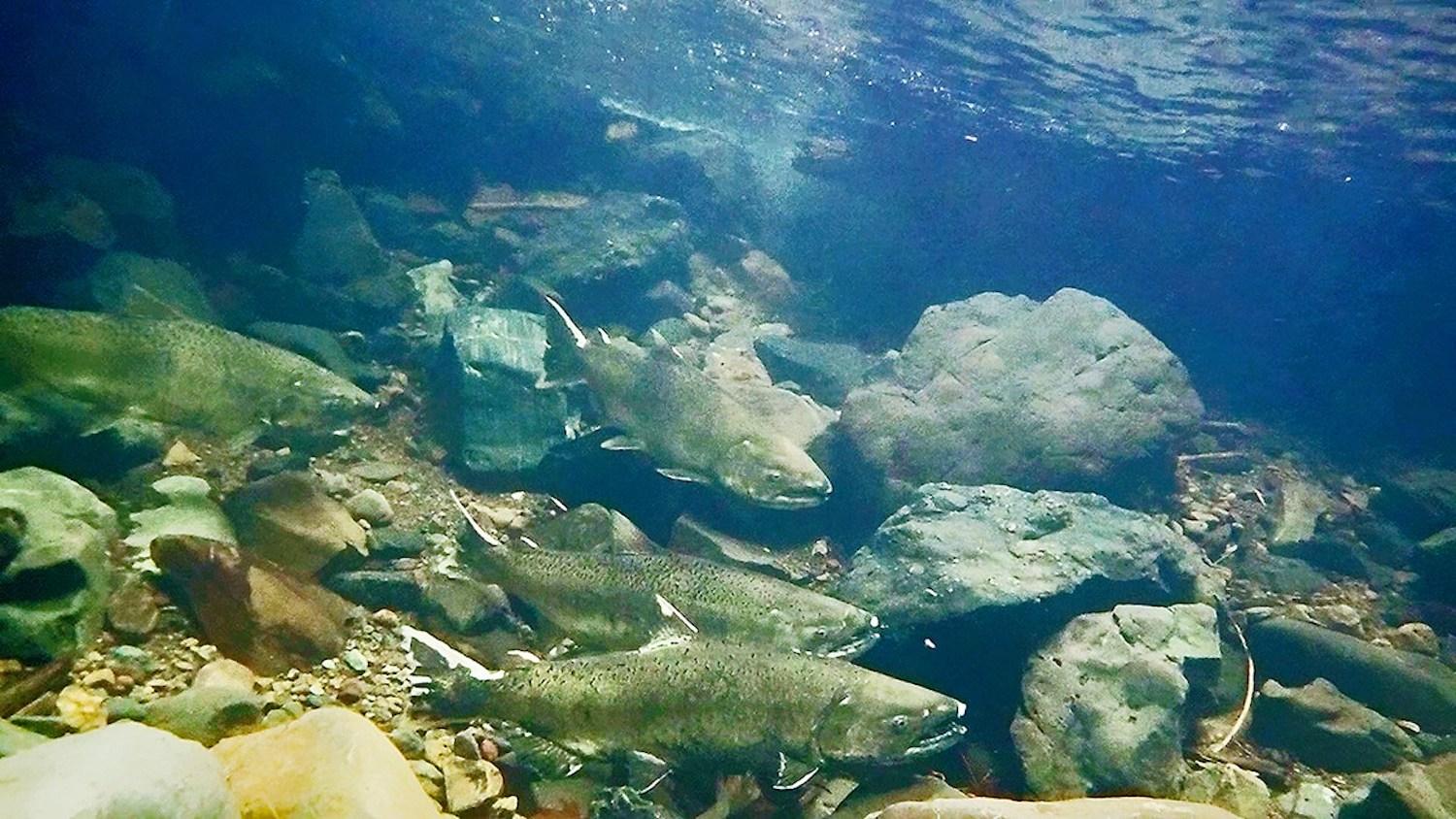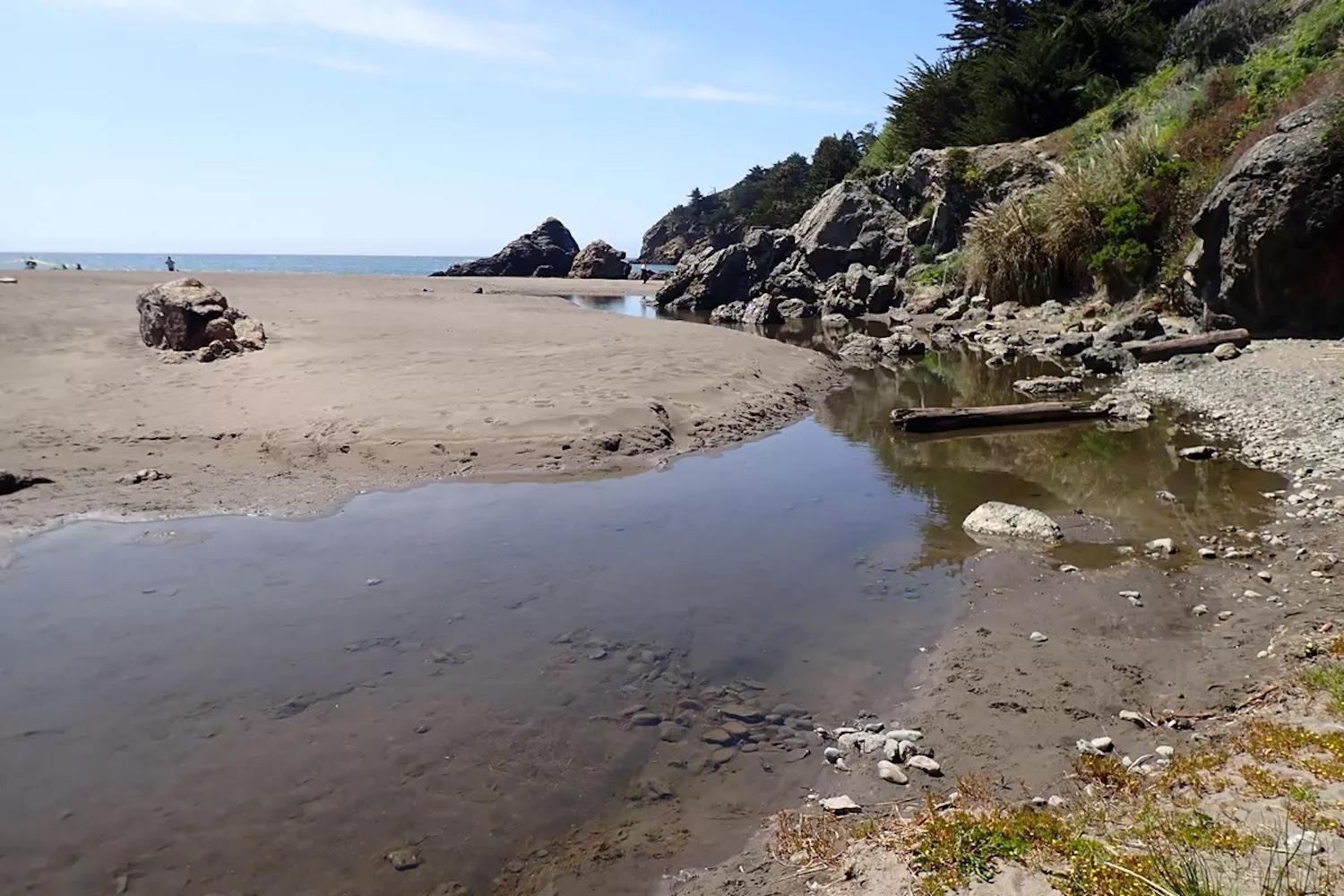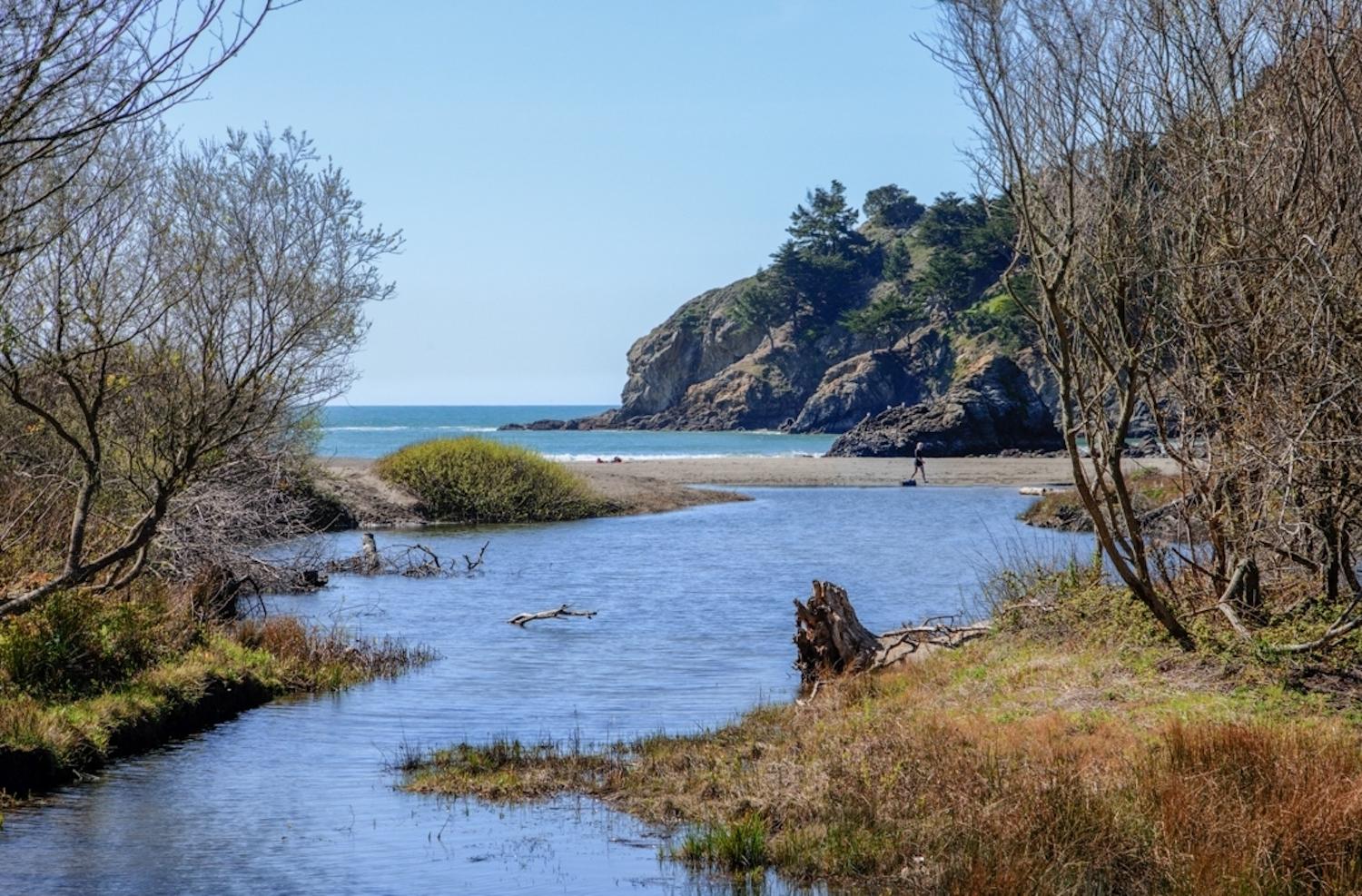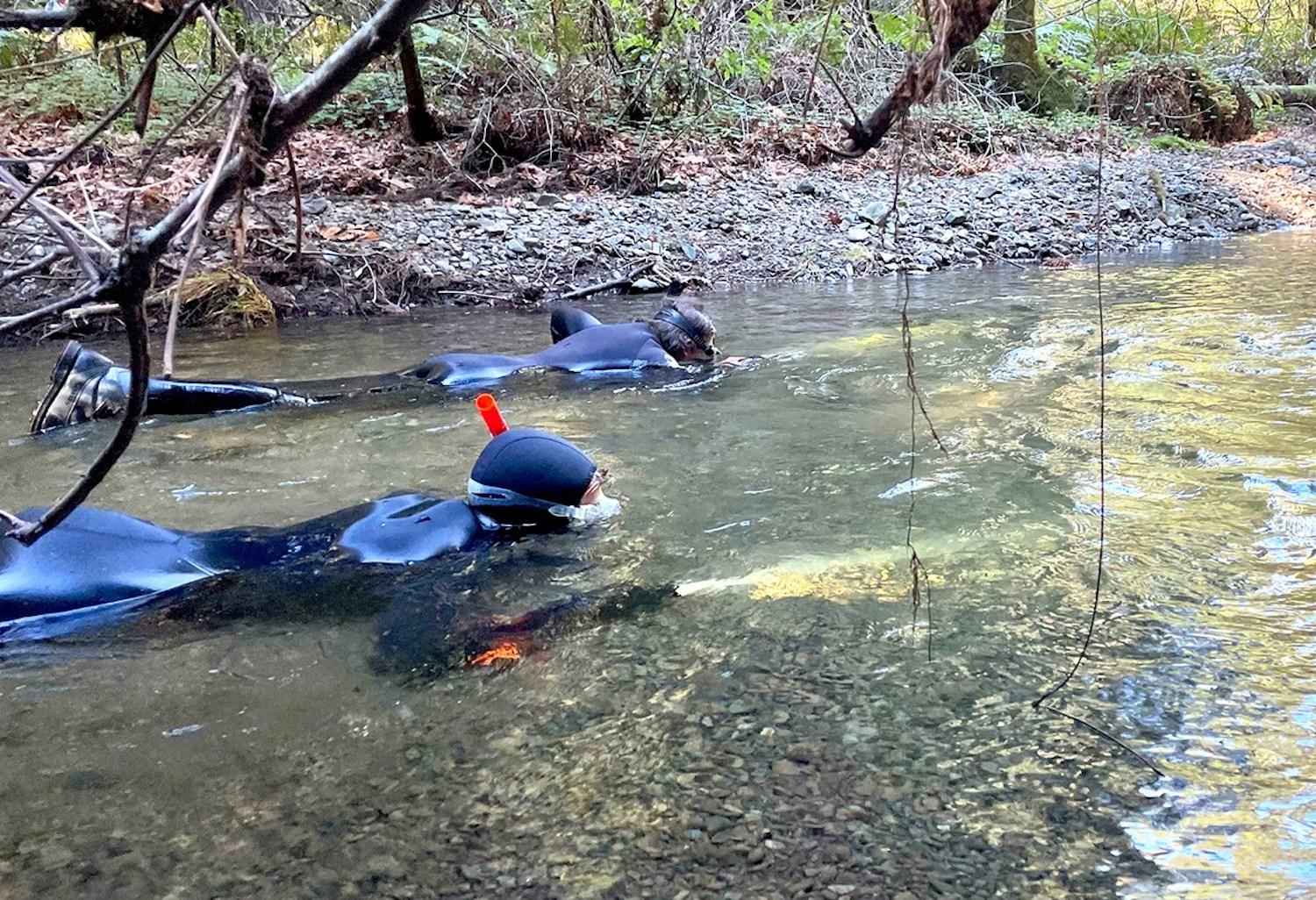
Adult Chinook salmon in Redwood Creek, Muir Woods National Monument/NPS, Natale Urquhart
Chinook
The mystery of the straying Chinook, climate change and salmon survival
By Rita Beamish
National Park Service fisheries biologist Michael Reichmuth was stunned just over a year ago to see Chinook salmon showing up in Redwood Creek, a tiny stream that meanders amid the towering coast redwood trees — some of the giants nearly 1,000 years old — in Muir Woods National Monument.
It wasn’t that this stream in Marin County north of San Francisco had no history of any salmon. It is home to two keystone species: endangered coho and steelhead, a threatened species. But Chinook, also called king salmon, are considerably larger — growing up to the three-foot range — and they tend to prefer comparatively larger waterways, notably making their home-base in rivers flowing from the Sierra down through the Sacramento-San Joaquin Delta to San Francisco Bay and the Pacific beyond.
And since salmon return to their natal waters to spawn — meaning where they were hatched and reared — their appearance beneath the redwood canopy counted as a mystery. They’d never been seen in Redwood Creek, said Reichmuth, who overseas coho monitoring at Redwood Creek nearby streams.
Park Service biologists thus were not remotely prepared to see fall-run Chinook when, using rods to poke through the creek in their high waders and water boots, they looked for signs of what they assumed would be coho possibly arriving to spawn after the heavy October 2021 storm.
“Is that really a Chinook?” Reichmuth recalled thinking as he scratched his head. “After a big storm like we had, the river was not that clear. I’m seeing these fish and thinking that doesn’t quite look like a coho. … When we first saw them, it was like, ‘that coho looks really big.’”
More unusual was the number — the team counted more than 80 on one day. Even a couple of strays would have been startling.
“It definitely seemed odd to see them in there,” said Reichmuth. The Chinook proceeded to spawn in the creek’s gravelly bottom. It’s not known how many of their young made their way back out to the ocean as smolts.
The anomaly raised a number of questions: Was this a one-time thing or would the Chinook come back in the next year’s spawning season? Where were they from? And why did they choose to exit the ocean here instead of using their homing instincts to swim another eight or so miles south to the San Francisco Bay, gateway to Chinook home waters in the Central Valley?
Further, would Chinook babies negatively compete with the already precarious coho in the creek or otherwise bully species in this national monument ecosystem, part of Golden Gate National Recreation Area, that preserves one of the San Francisco Bay Area’s last remaining ancient redwood forests?
What’s been learned, through state and federal monitoring programs, is part of a larger story, one that spotlights the evolving complexity of human efforts to ensure the continued existence of salmon populations beset by a range of challenges, mostly human-caused, and why it matters beyond the filet on a restaurant plate.
A Singular Event?
The fall 2022 spawning season answered the question of whether the Chinook would again come to Redwood Creek. They didn’t. And coho were not much in evidence either as their spawning season spilled over into this year, said Reichmuth.
Where had the Chinook come from before entering and exiting the ocean? Tiny coded wire tags recovered from their carcasses revealed they were fall-run Chinook from a California Fish and Wildlife hatchery in the state’s Central Valley. The carcasses remained in Redwood Creek after the Chinook deposited their eggs — post-spawning mortality being a normal part of their life cycle.

Fisheries Biologist Michael Reichmuth searches for coho salmon and steelhead trout spawning activity in Redwood Creek. The National Park Service has been monitoring salmonids in coastal San Francisco Bay Area national park creeks since 1998/NPS, Maritte O’Gallagher
Fall-run Chinook — meaning the fall is when they return from the ocean to spawn — are the most abundant of the four Chinook runs in the Central Valley and are crucial to commercial and recreational fisheries that generate $900 million in the state’s economy, according to state Fish and Wildlife officials. Fall-run Chinook are considered a “species of concern” due to population declines and the reliance on hatcheries, a crucial strategy to maintain their abundance amid a decline in naturally spawning numbers.
Five major hatcheries in the Central Valley nurture Chinook eggs and rear them to the juvenile “smolt” stage, ready to swim downstream to the ocean. At sea, the fish spend between two and as many as five years eating to maturity before returning to spawn in their natal rivers. Their biology includes an olfactory imprinting on the rivers from their early life that guides them toward the unique “signature” of those waters.
California hatcheries have significantly increased fish production to compensate for drought-related mortality, as well as a thiamine deficiency linked to the ocean food web that now plagues the Chinook’s natural spawning in rivers, affecting the viability of the eggs laid by the females.
A Tough Migration
But scientists have long realized that hatcheries alone are not enough to ensure that the fish thrive.
The smolts still have to navigate a treacherous course to the ocean, one riddled with predators and waterways that have been long engineered with dams, channels, and diversion of water for agriculture and thirsty populations. The flow of these waterways to and through the massive San Francisco-San Joaquin Delta to the bay drives California’s notorious fights over allocation and conservation of the precious liquid they carry.
What the salmon need is good-flowing, cold water, and climate change is adding even more stress to the system. Lower and warmer stream waters — California is in its third year of the latest extended drought — create longer transit time and more circuitous migration swims. Young fish are then exposed to poor water quality as well as birds and other predators.
“It’s pretty obvious that the Sacramento-San Joaquin Delta is not a good place for the juvenile Chinook salmon as they’re making their way from those Sierra streams down to the ocean,” said Reichmuth. “Most of them die.”
Adult salmon swimming back upstream to spawn are not as fragile but also suffer in diminished, warmer waterways and less spawning habitat, said Peter Tira, information officer for California Fish and Wildlife.
“So you get hit on two ends of the life cycle,” he added.
A major response by California management officials is a massive trucking program, with the juvenile Chinook as passengers. Specialized tanker trucks ferry millions of the young from 50 to 100 miles around the hazard-plagued migration routes, and then release them to locations around the San Francisco and San Pablo bays.
State officials last year took the truck operation to a new level. Alarmed by the prospect of yet another year of drought-caused, poor stream conditions, they transported and released nearly all of the Central Valley hatchery-raised, fall-run Chinook, almost 20 million fish, said Tira, along with nearly 1 million spring-run Chinook smolts that are listed as threatened under the Endangered Species Act.
Not All Salmon Find Their Way Home
Those 2022-released smolts are not yet ready to return from the ocean for spawning. But for the 2021 Redwood Creek strays, coded wire tags showed they were from a release three years earlier off Fort Baker, in the shadow of the Golden Gate Bridge. At the mouth of the bay, it’s the release site closest to the ocean.
“There’s data to show as you move further out to the ocean the survival of those fish is greater, both to the fishery and back to the hatchery,” said Jonathan Nelson, environmental program manager in the anadromous fish conservation and management program of California Fish and Wildlife.
Still, scientists are “hedging our bets,” he said, by using multiple release sites as they evaluate the success of releases at different sites, including in deeper waters to which the salmon are towed in net pens.
“We keep adapting based on water years and what we see on subsequent return in how we continue to release fish,” Nelson said.

A stream channel links the lagoon and the ocean at Muir Beach, near Redwood Creek/NPS

Restoration of Redwood Creek has helped improve the fishery. This view follows the creek down into the lagoon on Muir Beach/NPS Kirke Wrench
So why did the straying Chinook pick Redwood Creek instead of swimming at least back to Fort Baker, or plying the water miles to their natal waters at the Mokelumne Hatchery?
The incursion was undoubtedly linked to an atmospheric river that brought historic early rains to the Muir Woods region in October 2021, said Reichmuth. Rainwater and waves pounded through a Muir Beach sandbar that must be breached each year before fish — typically the returning Coho followed by steelhead, which spawn a little later — have a pathway into Redwood Creek.
Straying here and there is not unusual, but “If they had homing, they’d go up the delta and get out in its various tributaries,” Reichmuth said. “It’s mainly these ones that don’t have that homing – it’s like ‘here’s a stream nearby and it looks great. Let’s go.’”
The release program ensures a viable fishery, he noted. “But by doing this release there’s the unnatural consequence of having fish turn up” out of place, especially when confused by conditions like the major 2021 flow at Redwood Creek.
Small numbers of fish, even from the naturally spawned population, do stray in coastal waters and across watersheds each year, Nelson said, while others find their way back to the their birth waters. But salmon “are attracted to water flow regardless of their signature, where they’re homing from. They’ll just divert if they feel there’s a strong pull of water” with nutrients for spawning.
“The problem is in years of low water, if there’s not enough water coming out of a particular river,” the signature is not distinct, “and when they come in there’s potential confusion on where they should be homing to,” Nelson said. Some Chinook may even end up at the wrong hatchery, perhaps following other salmon upstream.
Based on the return data, “we continually try to use adaptive management to tweak our management strategies to try to minimize some of those potential issues that have occurred if fish are just swimming around and not going back to the hatchery or the rivers that they are originally from,” he said.
The Natives Are OK
The Chinook presence last year raised questions about potential impact on Redwood Creek coho. Central California Coast coho populations have been reduced to about 1% of their historic levels by habitat loss, overfishing and changing ocean conditions, according to the Park Service.
“I think the outcome people were concerned about was there would be all these Chinook around, and coho babies would be eating less and spend their time trying to fight off these other salmon,” said Darren Ward, a Pacific salmon expert and Cal Poly Humboldt State University professor.
“It doesn’t look that was happening,” said Ward after analyzing video monitoring of the the hatched fish for the Park Service. Video from multiple Redwood Creek pools and in a watershed 20 miles north with a history of stray Chinook, recorded Chinook and coho young after the fall 2021 spawning. They were observed together, and then the Chinook were temporarily removed and the coho were observed alone.
No significant difference was apparent in the behavior and feeding of the coho before and after the Chinook were removed, said Ward. He said further research would be needed to know if there were any other impacts, such as on nesting sites.

Fisheries Crew Leader Brentley McNeill and Hydrologic Technician Karl Kindall snorkeling in the creek to find yearling coho and steelhead/NPS, Natale Urquhart
What’s Ahead For The Salmon?
California welcomed 2023 under a deluge of historic atmospheric river storms that pounded dry earth into mud and raised water levels in parched reservoirs. Still, the state overall remains abnormally dry or in drought, and experts say it’s too early to know if, like last year, the storms’ boost will succumb to renewed exceptionally dry conditions.
For the salmon, the 2023 winter storms came at the tail end of the spawning season for Central Valley fall-run Chinook, and thus likely had little impact, said Nelson. Good flows through the spring, with some turbidity, would increase survival of migrating smolts. But for returning fall-run Chinook in the Central Valley, it was overall a poor year, he said. “The biggest issue is that due to the poor returns there may not be as many in the system to take advantage of the improved conditions.”
Annual adult return estimates are not in yet, “but based on inland angling surveys and spawning surveys, there are much lower numbers being reported than normal years,” he said. And that does not bode well for the next spawning season.
Wildlife officials will again truck and release some Chinook this April-June. Evaluation of conditions and survival prospects at that time will guide their decisions on how many.
The big picture: Aside from the trucking program, wildlife managers also boost survival by treating salmon and fish in the hatcheries to counter the thiamine deficiency. With overall poor in-river conditions continuing, and naturally occurring Chinook far below the levels they should be, “The hatcheries are going to continue to maintain the survival of these fish,” said Nelson.
“But if we continue to have poor water conditions both in the river and food sources in the ocean, we may see down the road that the only thing that’s remaining are hatcheries. That’s not our goal. We want the opposite, and unfortunately we’re leaning on our hatcheries to keep things going during these really low years. But it will have consequences to our wild populations and to our in-river spawning population.“
The Traveler's science coverage from the National Park System is made possible in part thanks to Earthjustice.

